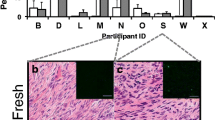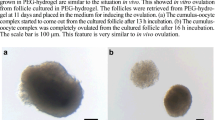Abstract
Ovarian follicle growth and oocyte maturation require communications between the oocyte and its surrounding somatic cells. Three-dimensional structures provide cell culture conditions that increase interactions between the cellular components when compared to 2-dimensional structures. In this study, alginate matrices were employed to maintain a 3-dimensional architecture to examine its effects on in vitro culture outcomes using mouse ovarian follicles. Ovaries were obtained from the 14-day-old C57BL/6 mice, and preantral follicles were isolated and cultured in either a 2-dimensional culture system or 0.125/0.25% alginate matrices-based 3-dimensional culture systems. We successfully observed encapsulation within 0.125 and 0.25% alginate matrices, which maintained the follicular spherical architecture, with a centrally placed oocyte and layers of granulosa cells. All culture outcomes were comparable between the 2-dimensional control and 3-dimensional alginate group. However, 0.25% alginate hydrogels led the lower rates of follicle survival and antral formation in comparison to the 2-dimensional control and 0.125% alginate. These results demonstrate that a non-permissive stiffness from the high concentration of alginate could interfere with cell-to-cell communication of oocytes and follicles. The extracellular matrix interacts with the oocyte and granulosa cells, resulting in direct effects on their proliferation. The development of a 3-dimensional culture system can enhance follicle maturation and produce meiotically-competent oocytes to provide advanced reproductive options for IVF patients in the future.
Similar content being viewed by others
References
AC Varghese, SS du Plessis, T Falcone, et al., Cryopreservation/transplantation of ovarian tissue and in vitro maturation of follicles and oocytes: challenges for fertility preservation, Reprod Biol Endocrinol, 6, 47 (2008).
M von Wolff, J Donnez, O Hovatta, et al., Cryopreservation and autotransplantation of human ovarian tissue prior to cytotoxic therapy—a technique in its infancy but already successful in fertility preservation, Eur J Cancer, 45, 1547 (2009).
KY Cha, RC Chian, Maturation in vitro of immature human oocytes for clinical use, Hum Reprod Update, 4, 103 (1998).
MJ Carabatsos, C Sellitto, DA Goodenough, et al., Oocyte granulosa cell heterologous gap junctions are required for the coordination of nuclear and cytoplasmic meiotic competence, Dev Biol, 226, 167 (2000).
JJ Eppig, AC Schroeder, Capacity of mouse oocytes from preantral follicles to undergo embryogenesis and development to live young after growth, maturation, and fertilization in vitro, Biol Rreprod, 41, 268 (1989).
RL Herlands, RM Schultz, Regulation of mouse oocyte growth: probable nutritional role for intercellular communication between follicle cells and oocytes in oocyte growth, J Exp Zool 229, 317 (1984).
PK Kreeger, NN Fernandes, TK Woodruff, et al., Regulation of mouse follicle development by follicle-stimulating hormone in a three-dimensional in vitro culture system is dependent on follicle stage and dose, Biol Reprod, 73, 942 (2005).
SA Pangas, H Saudye, LD Shea, et al., Novel approach for the three-dimensional culture of granulosa cell-oocyte complexes, Tissue Eng, 1013 (2003).
E Cukierman, R Pankov, DR Stevens, et al., Taking cell-matrix adhesions to the third dimension, Science, 294, 1708 (2001).
PK Kreeger, JW Deck, TK Woodruff, et al., The in vitro regulation of ovarian follicle development using alginateextracellular matrix gels, Biomaterials, 27, 714 (2006).
M Xu, A Banc, TK Woodruff, et al., Secondary follicle growth and oocyte maturation by culture in alginate hydrogel following cryopreservation of the ovary or individual follicles, Biotechnol Bioeng, 103, 378 (2009).
KY Lee, DJ Mooney, Alginate: properties and biomedical applications, Prog Polym Sci, 37, 106 (2012).
A Gutowska, B Jeong, M Jasionowski, Injectable gels for tissue engineering, Anat Rec, 263, 342 (2001).
JA Rowley, G Madlambayan, DJ Mooney, Alginate hydrogels as synthetic extracellular matrix materials, Biomaterials, 20, 45 (1999).
ER West, M Xu, TK Woodruff, et al., Physical properties of alginate hydrogels and their effects on in vitro follicle development, Biomaterials, 28, 4439 (2007).
M Xu, PK Kreeger, LD Shea, et al., Tissue-engineered follicles produce live, fertile offspring, Tissue Eng, 12, 2739 (2006).
M Xu, E West, LD Shea, et al., Identification of a stage-specific permissive in vitro culture environment for follicle growth and oocyte development, Biol Reprod, 75, 916 (2006).
M Heise, R Koepsel, A Russell, et al., Calcium alginate microencapsulation of ovarian follicles impacts FSH delivery and follicle morphology. Reprod Biol Endocrinol, 3, 47 (2005).
A Shikanov, M Xu, TK Woodruff, et al., Interpenetrating fibrinalginate matrices for in vitro ovarian follicle development, Biomaterials, 30, 5476 (2009).
M Xu, ER West-Farrell, RL Stouffer, et al., Encapsulated threedimensional culture supports development of nonhuman primate secondary follicles, Biol Reprod, 81, 587 (2009).
CA Amorim, A Van Langendonckt, A David, et al., Survival of human pre-antral follicles after cryopreservation of ovarian tissue, follicular isolation and in vitro culture in a calcium alginate matrix, Hum Reprod, 24, 92 (2009).
MA Mainigi, T Ord, RM Schultz, Meiotic and developmental competence in mice are compromised following follicle development in vitro using an alginate-based culture system, Biol Reprod, 85, 269 (2011).
M Xu, SL Barrett, E West-Farrell, et al., In vitro grown human ovarian follicles from cancer patients support oocyte growth, Hum Reprod, 24, 2531 (2009).
SY Jin, L Lei, A Shikanov, et al., A novel two-step strategy for in vitro culture of early-stage ovarian follicles in the mouse, Fertil Steril, 93, 2633 (2010).
D Tagler, T Tu, RM Smith, et al., Embryonic Fibroblasts Enable the Culture of Primary Ovarian Follicles Within Alginate Hydrogels, Tissue Eng Part A, (2012).
JJ Eppig, K Wigglesworth, FL Pendola, The mammalian oocyte orchestrates the rate of ovarian follicular development, Proc Natl Acad Sci U S A., 99, 2890 (2002).
Author information
Authors and Affiliations
Corresponding author
Additional information
These authors contributed equally to this work
Rights and permissions
About this article
Cite this article
Park, K.E., Kim, Y.Y., Ku, SY. et al. Effects of alginate hydrogels on in vitro maturation outcome of mouse preantral follicles. Tissue Eng Regen Med 9, 170–174 (2012). https://doi.org/10.1007/s13770-012-0170-x
Received:
Revised:
Accepted:
Published:
Issue Date:
DOI: https://doi.org/10.1007/s13770-012-0170-x




